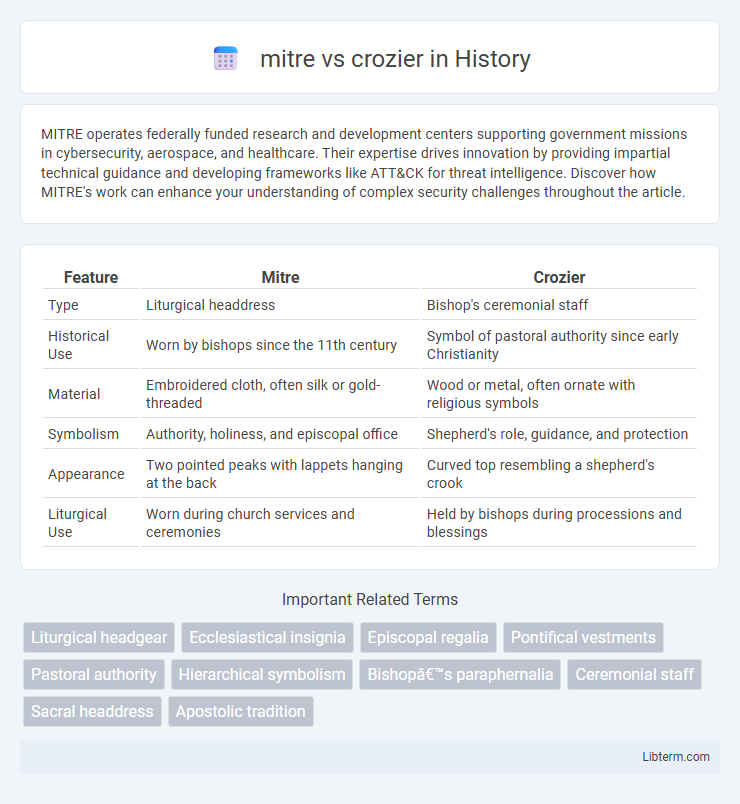MITRE operates federally funded research and development centers supporting government missions in cybersecurity, aerospace, and healthcare. Their expertise drives innovation by providing impartial technical guidance and developing frameworks like ATT&CK for threat intelligence. Discover how MITRE's work can enhance your understanding of complex security challenges throughout the article.
Table of Comparison
| Feature | Mitre | Crozier |
|---|---|---|
| Type | Liturgical headdress | Bishop's ceremonial staff |
| Historical Use | Worn by bishops since the 11th century | Symbol of pastoral authority since early Christianity |
| Material | Embroidered cloth, often silk or gold-threaded | Wood or metal, often ornate with religious symbols |
| Symbolism | Authority, holiness, and episcopal office | Shepherd's role, guidance, and protection |
| Appearance | Two pointed peaks with lappets hanging at the back | Curved top resembling a shepherd's crook |
| Liturgical Use | Worn during church services and ceremonies | Held by bishops during processions and blessings |
Overview: Mitre vs Crozier
A mitre is a ceremonial headdress worn by bishops and abbots, symbolizing their authority within the Christian church, characterized by its pointed, folding structure. A crozier, also known as a pastoral staff, is a curved staff carried by high-ranking clergy, representing the bishop's role as a shepherd guiding the faithful. Both items serve as significant liturgical symbols, embodying spiritual leadership and ecclesiastical power.
Historical Origins of the Mitre and Crozier
The mitre and crozier both originate from early Christian liturgical traditions, with the mitre evolving from the camelaucum, a cap worn by Roman officials, symbolizing episcopal authority by the 11th century. The crozier, resembling a shepherd's staff, traces back to the pastoral symbolism used by bishops in the early Middle Ages to represent their role as spiritual shepherds guiding their flock. These artifacts gradually took on formalized designs reflecting ecclesiastical hierarchy and authority across Western Christianity.
Symbolic Meanings in Christian Tradition
The mitre symbolizes the authority and spiritual leadership of bishops, reflecting their role as shepherds guiding the Christian flock, often associated with the tongues of fire at Pentecost. The crozier represents pastoral care and the bishop's duty to oversee and protect the faithful, resembling a shepherd's staff used to guide and guard sheep. Together, these symbols articulate the balance of power and pastoral responsibility inherent in episcopal ministry within Christian tradition.
Structural Differences: Design and Materials
The mitre features a stiff, pointed double-peaked structure made typically from fabric-covered cardboard or stiffened silk, designed to sit pointedly on the head and symbolize ecclesiastical authority. In contrast, the crozier incorporates a long staff with a curved or spiral top, often crafted from wood or metal and adorned with intricate carvings or precious metals, representing pastoral leadership and guidance. These structural differences highlight the mitre's role as ceremonial headwear and the crozier's function as a symbolic shepherd's staff within religious contexts.
Liturgical Use and Significance
The mitre, a tall, pointed headdress, symbolizes the authority of bishops during liturgical ceremonies, marking their teaching and governing roles within the church hierarchy. The crozier, a staff with a curved top resembling a shepherd's crook, represents the pastoral care and guidance a bishop provides to their flock, emphasizing spiritual leadership. Both items are essential liturgical vestments, highlighting different aspects of episcopal ministry and authority during worship services.
Regional Variations in Use
The mitre is predominantly used in Western Christian traditions such as Roman Catholicism and Anglicanism, while the crozier is common across both Western and Eastern Christian rites, including Orthodox churches. Regional variations include the mitre's pointed, two-peak design in Western Europe, contrasting with the rounded or bulbous Eastern mitres. In Ireland and Scotland, the crozier often features intricate Celtic knotwork, reflecting local heritage and artistic styles.
Mitre and Crozier in Modern Ceremonies
The mitre and crozier remain essential symbols of episcopal authority in modern ceremonies, with the mitre representing the bishop's spiritual authority and the crozier symbolizing pastoral care and guidance. Contemporary use of the mitre often features intricate embroidery and rich materials, emphasizing tradition and continuity within liturgical celebrations. Meanwhile, the crozier's design varies from ornate to simpler forms, reinforcing the bishop's role as shepherd to the faithful during rites and solemn events.
Prominent Examples Throughout History
The mitre, a tall, pointed ceremonial headpiece, prominently appears in the regalia of Catholic bishops and abbots, symbolizing their authority and spiritual leadership, as seen in the papal ceremonies of the Vatican. The crozier, a curved staff resembling a shepherd's crook, has been historically carried by bishops and abbots such as St. Augustine of Canterbury, emphasizing their role as shepherds of their flock. Throughout history, iconic representations, including the medieval frescoes at Canterbury Cathedral, highlight the mitre and crozier as enduring symbols of ecclesiastical power and pastoral care.
Controversies and Reforms
The mitre and crozier have sparked controversies due to their symbolism of ecclesiastical authority, often criticized for perpetuating hierarchical divisions within the church. Reforms aimed at simplifying or limiting the use of these liturgical items seek to emphasize humility and pastoral service over ceremonial grandeur. Debates continue over whether retaining these traditional symbols aligns with modern calls for transparency and inclusivity in church leadership.
Future Trends in Ecclesiastical Insignia
Future trends in ecclesiastical insignia indicate a growing preference for innovative materials and sustainable production methods in mitres and croziers, reflecting environmental stewardship within the Church. Digital fabrication techniques such as 3D printing allow for intricate designs that blend traditional symbolism with contemporary aesthetics, enhancing personalization for bishops. Advancements in augmented reality may also provide interactive experiences, deepening the faithful's engagement with the spiritual significance of these sacred emblems.
mitre Infographic

 libterm.com
libterm.com